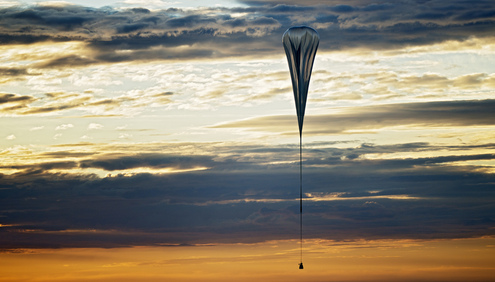Cold Front Imminent For Launch Target Date For Red Bull Stratos Mission
The latest forecast indicates that the weather window for Felix Baumgartner’s Red Bull Stratos mission remains open even though cold fronts moving in.
 ROSWELL (New Mexico) – The latest weather report suggests that Monday, October 8, continues to hold possibilities for the launch of Felix Baumgartner’s Red Bull Stratos mission. On October 1, meteorologist Don Day advised that cold fronts moving east and southeast of the Rocky Mountains are expected to bring cooler temperatures to the Roswell area, but and also hold the potential for low clouds.
ROSWELL (New Mexico) – The latest weather report suggests that Monday, October 8, continues to hold possibilities for the launch of Felix Baumgartner’s Red Bull Stratos mission. On October 1, meteorologist Don Day advised that cold fronts moving east and southeast of the Rocky Mountains are expected to bring cooler temperatures to the Roswell area, but and also hold the potential for low clouds.
“The timing of these cold fronts will be critical, as low clouds and moisture and increasing wind will be associated with each front,” Day remarked on Monday in assessing the weather’s impact on Baumgartner’s history-making attempt at supersonic freefall from an altitude of 120,000 feet (36,576 meters). “The timing of the fronts could change within 24 hours, but we expect further clarity by Friday.”
“I am ready,” said Baumgartner, a 43-year-old Austrian adventurer who has been training with the Red Bull Stratos team for the jump from the edge of space for more than five years. The winds must be calm, less than 2 miles/3 kilometers per hour at take-off, because the balloon is a mere 0.0008 inches thick – or 10 times thinner than a plastic sandwich bag.
Ideal weather conditions are essential for the launch because of the delicate eight-hour long process of laying out and pumping helium into the 55-storey high balloon that will carry Baumgartner and his over 1,300-kg space capsule to the stratosphere. The balloon, the largest ever used made for manned flight, was constructed out of strips of high-performance polyethylene, a plastic film. These strips that would cover 40 acres if they were laid out flat on the ground. The balloon’s height when it reaches jump altitude will be 334 feet (102 meters), with a diameter of 424 feet (129 meters).
The launch on October 8 is scheduled for dawn, which is the best time with ideal wind conditions to avoid tearing the mammoth balloon envelope. Eight hours before the launch, a specially trained 15-man crew will begin preparing for the balloon’s one and only flight. The crew will closely remove any dirt or fine debris from the runway that could damage the balloon before a team of about 10, wearing cotton cloves and protective clothing to prevent snags, will carefully move the boxed balloon from the hangar and begin laying it out on a protective layer of Herculite, a durable fabric.
One hour before the launch, Crew Chief Ed Coca will get clearance from Don Day and Mission Control to begin the final countdown and give the order to start inflating the balloon, which has an un-inflated weight of 3,708 pounds / 1,682 kilograms. It will take about 45 to 60 minutes to pump the helium, a non-flammable gas that is lighter than air, from two trucks into the balloon while a third truck with specially designed equipment will hold down the balloon.
The balloon, 10 times larger than the balloon used by Joe Kittinger for his record jump from 102,800 feet (31,333 meters) 52 years ago, which Baumgartner will be trying to beat, will be tall and thin at the launch.
The delicate process and entire mission can be watched live on www.redbullstratos.com



